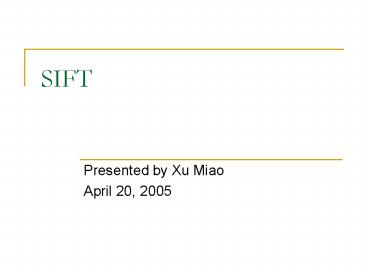SIFT PowerPoint PPT Presentation
1 / 24
Title: SIFT
1
SIFT
- Presented by Xu Miao
- April 20, 2005
2
Outline
- Motivation of SIFT
- Scale-space extrema detection
- Scale-space function
- Local extrema detection
- Detection sampling
- Keypoint localization
- Orientation assignment
- Keypoint descriptor
- Comparison of Harris-Laplacian and SIFT
- Image matching
3
Motivation of SIFT (copy from 576 slides)
- Image content is transformed into local feature
coordinates that are invariant to translation,
rotation, scale, and other imaging parameters
SIFT Features
4
Motivation of SIFT--Advantages of local features
(copy)
- Locality features are local, so robust to
occlusion and clutter (no prior segmentation) - Distinctiveness individual features can be
matched to a large database of objects - Quantity many features can be generated for even
small objects - Efficiency close to real-time performance
- Extensibility can easily be extended to wide
range of differing feature types, with each
adding robustness
5
More motivation (copy)
- Feature points are used also for
- Image alignment (homography, fundamental matrix)
- 3D reconstruction
- Motion tracking
- Object recognition
- Indexing and database retrieval
- Robot navigation
- other
6
Scale-space extrema detection
- Scale-space function
- The only reasonable one
- Laplacian of Gaussian kernel is a good choice of
scale invariance - Difference of Gaussian kernel is a close
approximate to scale-normalized Laplacian of
Gaussian
7
Scale-space extrema detection
- Gaussian is an ad hoc solution of heat diffusion
equation - Hence
- k is not necessarily very small in practice
8
Scale Invariant Detection (Copy)
- Common approach
Take a local maximum of this function
(convolution of kernel and image)
Observation region size, for which the maximum
is achieved, should be invariant to image scale.
Important this scale invariant region size is
found in each image independently!
9
Scale-space extrema detection
2s
s2(1/s)
s
S 3
S2
10
Scale-space extrema detection
- Sampling in scale for efficiency
- How many scales should be used per octave? S?
- More scales evaluated, more keypoints found
- S lt 3, stable keypoints increased too
- S gt 3, stable keypoints decreased
- S 3, maximum stable keypoints found
11
Scale-space extrema detection
- Pre-smooth before extrema detection is equivalent
to spatial sampling - Sigma is higher, of stable keypoints is larger
- Lower sampling frequency preferred?
- To utilize the information smoothed off, first
double the original image, which also increases
the stable kepoints found by 4
12
Keypoint localization
- Detailed keypoint determination
- Sub-pixel and sub-scale location scale
determination - Ratio of principal curvature to reject edges and
flats (detect corners?)
13
Keypoint localization
- Sub-pixel and sub-scale location scale
determination
14
Keypoint localization
- Reject flats
- lt 0.03
- Reject edges
- r lt 10
- Is it Harris corner detector?
15
Keypoint localization
832
233x189
536
729
16
Orientation assignment
- Create histogram of local gradient directions at
selected scale - Assign canonical orientation at peak of smoothed
histogram - Each key specifies stable 2D coordinates (x, y,
scale,orientation)
17
Keypoint descriptor
- Invariant to other changes (Complex Cell)
In experiment, 4x4 arrays of 8 bin histogram is
used, in total of 128 features for one keypoint
18
Scale Invariant Detectors (copy)
- Harris-Laplacian1Find local maximum of
- Harris corner detector in space (image
coordinates) - Laplacian in scale
1 K.Mikolajczyk, C.Schmid. Indexing Based on
Scale Invariant Interest Points. ICCV 20012
D.Lowe. Distinctive Image Features from
Scale-Invariant Keypoints. Accepted to IJCV 2004
19
Scale Invariant Detectors(copy)
- Experimental evaluation of detectors w.r.t.
scale change
Repeatability rate
correspondences possible correspondences
K.Mikolajczyk, C.Schmid. Indexing Based on Scale
Invariant Interest Points. ICCV 2001
20
Comparison with Harrison-Laplacian
- Affine-invariant comparison
- Translation-invariant local features
- Rotation-invariant
- Harrison-Laplacian
- PCA
- SIFT
- Orientation
- Shear-invariant
- Harrison-Laplacian
- Eigen values
- SIFT
- No
- Within 50 degree of viewpoint, SIFT is better
than HL, after 70 degree, HL is better.
21
Comparison with Harrison-Laplacian
- Computational time
- SIFT is few floating point calculation
- HL uses iterative calculation which costs much
more
22
Object recognition by SIFT keypoint matching
- Efficient nearest neighbor algorithm
- Best-Bin-First (modification of k-d tree)
- Hough transformation to cluster features into
3-feature groups - Solving affine parameters by pseudo-inversion to
verify the matching model - Final decision is made by Bayesian approach
23
(No Transcript)
24
(No Transcript)

